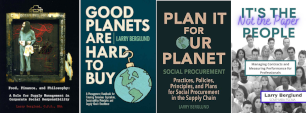Rodney didn’t get any. Aretha sang about it. Procurement doesn’t get what it feels it deserves. How does the latter group get the respect they want?
What is Supply Chain management missing?
Is Procurement an overhead cost or can it be classified as a profit centre? The accounting profession, for example, has one designation and everyone knows what that job entails — fiscal responsibility. The term Supply Chain can be vague and interpreted in different ways.
How does the Supply Chain get respect in the private sector?
The private sector has the focus on maximizing profitability. While they do embrace corporate social responsibility, they need to have the returns that affords the attention to CSR and community support.
Procurement is driven by key performance indicators such as cost of goods sold (COGS). Inventory turns, cycle times, cost of quality, and C2C metrics are common dashboard indicators. These are achieved through resilient partnerships and leading edge solutions. Results are reported on a regular basis to senior management.
The most important area is selling themselves internally. They take the time to understand operational and marketing issues now and in the future to make better decisions. Private sector does more objective benchmarking of key procurement metrics. Inventory targets are aggressive. Investment is made in ensuring skills sets are world class. Service from critical suppliers is measured and expected to be as good as possible on all fronts. Supply chain is paid for results which contribute to competitiveness.
This doesn’t mean that the private sector always does a better procurement job. Private sector companies fail; or are absorbed by more competitive players in the market; or bring in consultants to shake the tree; or at times, revise the rules to justify the end.

How can we advance the Supply Chain in the public sector?
The focus of public sector supply chains is on delivering services and goods in a timely fashion. Supply chains are the conduit for public policies on infrastructure, healthcare, education, defense and economic development. Budgets are set annually and are intended to be spent during that fiscal year
Procurement is often relegated to direct their focus on risk mitigation versus value add or strategic options that may be available. When procurement is successful in mitigating risks, they did their job and have avoided potential lawsuits or negative press. However, when this occurs regularly, it acts as a double-edged sword. It does not propel the organization to change or empower the procurement professionals to improve upon or increase their visibility within the organizations.
The traditional approach of procurement and its myopic focus on low costs inhibits the progress to achieve broader outcomes. To compound the situation further, savings are seen as claw-back items against operational or capital budgets acting as a disincentive to collaboration across or cooperation between departments.
Clients often want their deliverables met within politically-driven timelines. There are few options to expedite the business processes properly and procurement is seen as the problem. The client department has already “googled”, contacted, and predetermined a supplier to perform the services using an out-of-date request document. By the time the order hits the procurement desk it has already been “rubber stamped.” It is then too late to proceed with a better competitive process to meet deadline requirements.
In many public sector organizations, decentralized authority encourages a large contingent of well-intentioned departments that like to negotiate. The only intent is to buy something cheaper, ergo, it must be a good deal. Whether the deal conflicts with policies, existing contracts, or broader organizational objectives and expectations, is of little regard to the rogue buyers.
Procurement in the public sector needs an ongoing commitment to training. Not that there are not qualified educated procurement professionals working within the public sector- there definitely are! The aging population exasperates the lack of investment in training required to replace the number of experienced professionals.

How do we improve upon our situation? We need to rebuild our village.
- Actively participate with other business disciplines at a professional level.
- Stop with the procurement speak and speak the language of our counterparts. Our clients want to feel heard too.
- Focus on the outcome without the process being the main topic of discussion.
- Build internal client and external stakeholder relationships to encourage communications.
- Develop KPIs and expect to be measured for your professional contribution to the organization’s success.
- Argue for a total cost of ownership to drive value vis-à-vis the out-of-pocket cost.
- Host lunch-and-learn sessions on the requirements of public bidding with client departments.
- Be the go-to resource in an organization which contributes to a shared responsibility for measurable outcomes.
- Keep senior management informed on leading supply chain practices you have researched.
- Don’t accept the status quo of current process cycles. Fix it — otherwise you are condoning mediocrity.
- Measure supplier performance and report out on the objective findings. Don’t enable poor performance.
- Don’t use weak or lax policies as excuses — keep them current and leading edge.
- Exercise your supply chain professionalism to affect change.
By achieving results, we can build our brand thus forming positive relationships. We might even get some respect.
Many thanks to the following contributors:
Collin Ashton SCMP
Wende Kinch SCMP
Chris McAuley SCMP
Thanks,
Larry Berglund.

